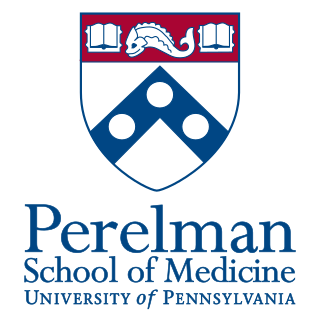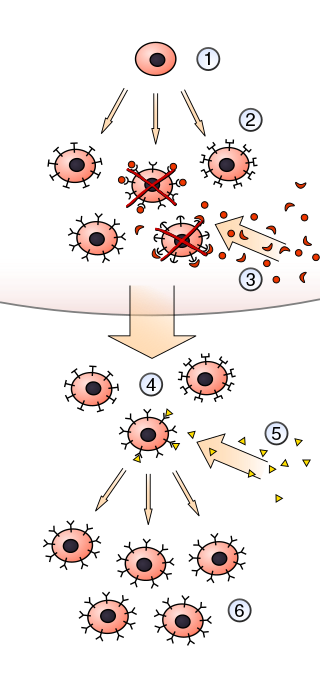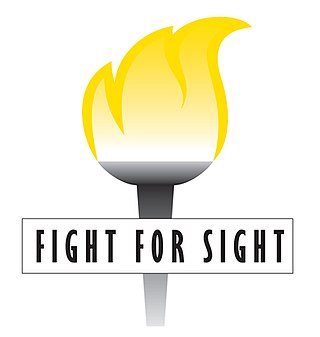Related Research Articles

In immunology, an antigen (Ag) is any molecule, molecular structure, foreign particulate matter, or pollen grain that can bind to a specific antibody or T-cell receptor. The presence of antigens in the body may trigger an immune response. Antigens can be proteins, peptides, polysaccharides, lipids, or nucleic acids.

Paul Ehrlich was a Nobel Prize-winning German physician and scientist who worked in the fields of hematology, immunology, and antimicrobial chemotherapy. Among his foremost achievements were finding a cure for syphilis in 1909 and inventing the precursor technique to Gram staining bacteria. The methods he developed for staining tissue made it possible to distinguish between different types of blood cells, which led to the ability to diagnose numerous blood diseases.

The Tulane University School of Medicine is located in New Orleans, Louisiana, United States and is a part of Tulane University. The school is located in the Medical District of the New Orleans Central Business District.
The side-chain theory is a theory proposed by Paul Ehrlich (1854–1915) to explain the immune response in living cells. Ehrlich theorized from very early in his career that chemical structure could be used to explain why the immune response occurred in reaction to infection. He believed that toxins and antitoxins were chemical substances at a time when very little was known about their nature. The theory explains the interaction of antibodies and antigens in the blood, and how antibodies are produced.

The Perelman School of Medicine is the medical school of the University of Pennsylvania, a private research university in Philadelphia, Pennsylvania. Founded in 1765, the Perelman School of Medicine is the oldest medical school in the United States and is one of the seven Ivy League medical schools.
Albany Medical College (AMC) is a private medical school in Albany, New York. It was founded in 1839 by Alden March and James H. Armsby and is one of the oldest medical schools in the nation. The college is part of the Albany Medical Center, which includes the Albany Medical Center Hospital. Along with Albany College of Pharmacy, Albany Law School, the Dudley Observatory, the Graduate College of Union University, and Union College, it is one of the constituent entities of Union University.
Tak Wah Mak, is a Canadian medical researcher, geneticist, oncologist, and biochemist. He first became widely known for his discovery of the T-cell receptor in 1983 and pioneering work in the genetics of immunology. In 1995, Mak published a landmark paper on the discovery of the function of the immune checkpoint protein CTLA-4, thus opening the path for immunotherapy/checkpoint inhibitors as a means of cancer treatment. Mak is also the founder of Agios Pharmaceuticals, whose lead compound, IDHIFA®, was approved by the FDA for acute myeloid leukemia in August 2017, becoming the first drug specifically targeting cancer metabolism to be used for cancer treatment. He has worked in a variety of areas including biochemistry, immunology, and cancer genetics.

In immunology, clonal selection theory explains the functions of cells of the immune system (lymphocytes) in response to specific antigens invading the body. The concept was introduced by Australian doctor Frank Macfarlane Burnet in 1957, in an attempt to explain the great diversity of antibodies formed during initiation of the immune response. The theory has become the widely accepted model for how the human immune system responds to infection and how certain types of B and T lymphocytes are selected for destruction of specific antigens.

Kimishige "Kimi" Ishizaka was a Japanese immunologist who, with his wife Teruko Ishizaka, discovered the antibody class Immunoglobulin E (IgE) in 1966–1967. Their work was regarded as a major breakthrough in the understanding of allergy. He was awarded the 1973 Gairdner Foundation International Award and the 2000 Japan Prize for his work in immunology.

Philippa "Pippa" Marrack, FRS is an English immunologist and academic, based in the United States, best known for her research and discoveries pertaining to T cells. Marrack is the Ida and Cecil Green Professor and chair of the Department of Biomedical Research at National Jewish Health and a distinguished professor of immunology and microbiology at the University of Colorado Denver.

Fight for Sight is a nonprofit organization in the United States which funds medical research in vision and ophthalmology. It was formed in 1946 as the National Council to Combat Blindness (NCCB), the first non-profit organization in the United States to fund vision research; 2011 marked its 65th anniversary.

James Patrick Allison is an American immunologist and Nobel laureate who holds the position of professor and chair of immunology and executive director of immunotherapy platform at the MD Anderson Cancer Center at the University of Texas.

King-Wai Yau is a Chinese-born American neuroscientist and Professor of Neuroscience at Johns Hopkins University School of Medicine in Baltimore, Maryland.
Richard D. Semba is an American ophthalmologist, medical researcher and professor. Semba currently is the W. Richard Green Professor of Ophthalmology at the Johns Hopkins School of Medicine, where he leads the Semba laboratory. He is Affiliated Faculty with the Center for a Livable Future at the Johns Hopkins Bloomberg School of Public Health.

Reza Dana is the Claes H. Dohlman Professor of Ophthalmology, senior scientist and W. Clement Stone Clinical Research Scholar at Massachusetts Eye and Ear, Harvard Medical School, and director of the Harvard-Vision Clinical Scientist Development Program.

David Wallach is a full professor at the Department of Biological Chemistry at Weizmann Institute of Science, Israel, laureate of the 2014 Emet Prize for Life Sciences. , and laureate of the 2018 The Paul Ehrlich and Ludwig Darmstaedter Prize.

Mark Morris Davis ForMemRS is director and Avery Family Professor of Immunology in the Institute for Immunity, Transplantation and Infection at Stanford University.
David Pressman was an American immunologist. He graduated from the California Institute of Technology in 1937 and received his PhD from the same institution in 1940. He remained at Caltech as a research fellow until 1947. During that time, he worked with Linus Pauling and Dan H. Campbell and the three published highly influential work on antibodies and antigens. Pressman then joined the faculty at the Sloan-Kettering Institute. He later moved to Roswell Park Comprehensive Cancer Center.

Daniel M. Albert is an American ophthalmologist, ocular cancer researcher, medical historian, and collector of rare books and ocular equipment. As of 2018, he is Professor of Ophthalmology at the Casey Eye Institute, Oregon Health & Science University.

Astrid Elsa Fagraeus-Wallbom, born May 30, 1913 in Stockholm, Sweden and died February 24, 1997, was a Swedish immunologist.
References
- 1 2 Cohn, Melvin; Av Mitchison, N.; Paul, William E.; Silverstein, Arthur M.; Talmage, David W.; Weigert, Martin (October 2007). "Reflections on the clonal-selection theory". Nature Reviews Immunology. 7 (10): 823–830. doi:10.1038/nri2177. PMID 17893695. S2CID 24741671.
- 1 2 Silverstein, Arthur M. (1995). Gallagher, Richard B.; Gilder, Jean; Nossal, Gustav J.V.; Salvatore, Gaetano (eds.). Immunology the Making of a Modern Science. Burlington: Elsevier. ISBN 9780080534534.
- ↑ "Arthur M. Silverstein". Association for Research in Vision and Ophthalmology. Retrieved 28 August 2016.
- ↑ "For The Record: Cheers". The Gazette Online. No. 29. 17 April 2000. Retrieved 28 August 2016.
- ↑ Silverstein, Arthur M. (2009). A history of immunology (2nd ed.). Amsterdam: Elsevier/Academic Press. ISBN 978-0-12-370586-0.
- ↑ Silverstein, Arthur M. (2002). Paul Ehrlich's receptor immunology the magnificent obsession . San Diego: Academic Press. ISBN 978-0-12-643765-2.